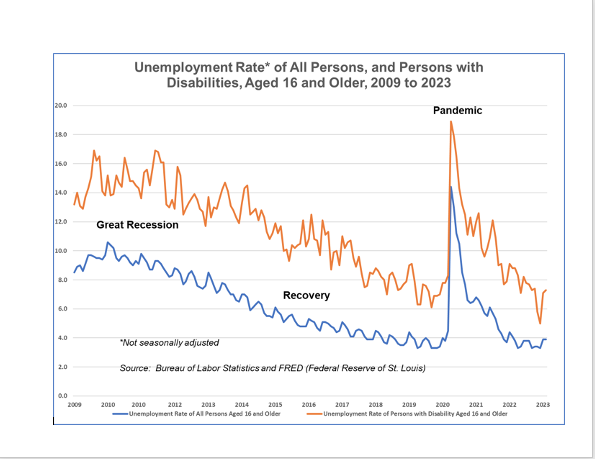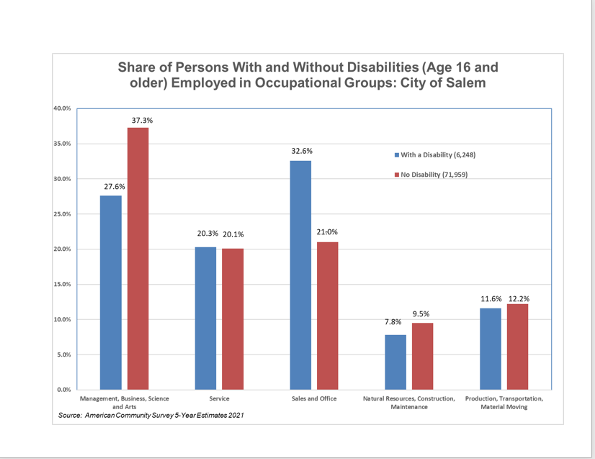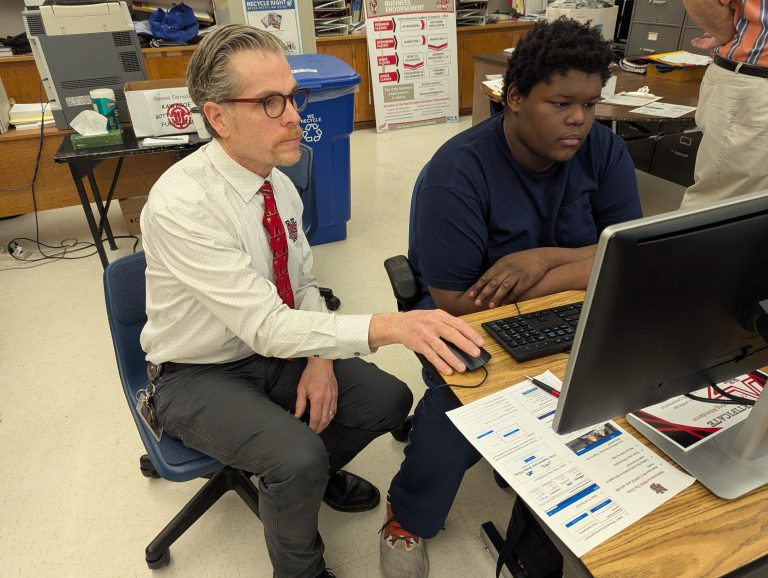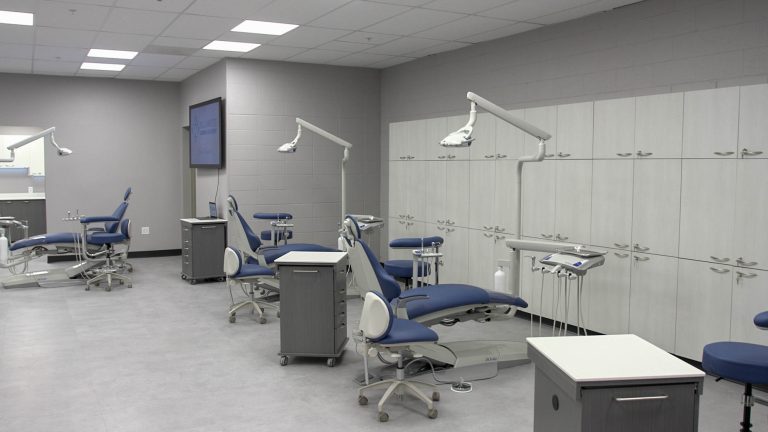Several hundred persons aged 16 and older with disabilities are actively looking for work in the city of Salem, according to the American Community Survey (of the U.S. Census.
Why, with a strong economy and more job openings than job seekers, are hundreds of persons with disabilities unemployed?
Let’s try to answer this question.
First, we’ll describe some characteristics of the population of persons with disabilities, and discuss employment and unemployment. Then, we’ll take a look at how persons with disabilities are defined and relate this to the economy.
It is important to note that there is no universally accepted definition of a disability. Rather, there are different definitions used for different purposes – for determining eligibility for public and/or private support programs, for example, and for the purpose of statistical analysis. This is at least one reason why estimates of the share of persons with disabilities in the population, as well as other related statistics, often substantially vary from one information source to another.
That brings us to the Census definition.
The Census divides disabilities into four groups: sensory, physical, mental, and self-care. Respondents to the American Community Survey self-report the lack of or presence of a disability.
According to the Census, Salem’s population includes some 24,000 persons with disabilities, 14 percent of the population. Nine percent are age 17 and younger, 52 percent are between ages 18 and 64, and 39 percent are over age 65.
According to the ACS, in the city of Salem, persons with disabilities are:
•Slightly more likely to be women than men.
•13 percent Latino.
•More likely to be employed part-time and more likely to be self-employed than those in the general population.
In addition, persons with disabilities have median earnings of about two-thirds of those without disabilities and twice the poverty rate.
Now let’s look more closely at employment and unemployment of persons with disabilities. The following information is from the federal Bureau of Labor Statistics, at the level of the U.S. It is applicable to the Salem area as well.
One measure of employment is the employment to population ratio, which is simply the number of those employed divided by the working age population and expressed as a percentage.
Of the working age population of persons with disabilities, 22 percent were employed in February. This was nearly 1.5 percentage points higher than in February 2022 – employment increased as the economy improved. However, 65 percent of the population with no disabilities was employed in February 2023.
Where do persons with disabilities work in Salem?
Some 6,200 persons with disabilities are employed in Salem, according to the American Community Survey.
The largest share, nearly one third, work in the occupational grouping of sales and office work. Twenty percent work in service-related occupations, the same share as workers with no disability. Twenty-eight percent of persons with disabilities work in the occupational group that includes management, a nearly ten percent smaller share than workers without disabilities.
The most recent unemployment rate for persons with disabilities was 7.3 percent in February 2023. This rate is near an historic low, and down by more than 1 percentage point from a year ago, due largely to the strong economy.

However, the rate for persons with disabilities, while historically low, is still nearly twice the rate of the overall population of job seekers.
Many unemployed job seekers with disabilities receive assistance in their job search from state agencies and nonprofits in the community.
The state of Oregon, Salem’s largest employer, has a state Department of Administrative Services program called ForwardOregon that provides work opportunities for persons with disabilities. It does this by designating certain services and products that state agencies buy as appropriate to be provided, through a qualified nonprofit, by persons with disabilities.
This ensures that firms employing persons with disabilities have opportunities to bid on state services and products.
The Vocational Rehabilitation Division of the Oregon Department of Human Services has recently won accolades from the Council of State Governments for its efforts in helping job seekers with disabilities find employment with private employers around the state.
A number of nonprofits in the area focus on helping persons with disabilities become employed. Garten is one of the best known, with a 53-year presence in Salem.
Easter Seals Oregon, another nonprofit assisting seniors with disabilities and with an office in Salem, calls out Safeway and Walmart for their commitments to hiring persons with disabilities.
However, according to Easter Seals, many employers don’t hire because they aren’t aware that many job seekers with disabilities are capable of fully performing a job.
And, says Brooke Ellison, a professor of Bioethics at Stony Brook, in a blog sponsored by Harvard Law School, many persons with disabilities possess unique skills, developed from having to cope with an environment decidedly unfriendly to their status. These skills could be useful in many work situations, particularly management-related ones.
So, we have to ask, again, why do job seekers with disabilities have such a high unemployment rate?
Ellison believes that the answer lies deeply embedded in our economic culture.
Briefly, here’s the argument: Disability has come to mean the inability to work productively. And productivity, the most accepted metric of a capitalist economy, is the all-important value.
This has consequences for persons with disabilities. At the least, their ability to contribute to productivity is de-valued and they are marginalized from the labor market.
Statistics on persons with disabilities and employment bear this out.
Ellison concludes that a mindset shift is needed, and that rebuilding the economy after Covid offers opportunities to “provide the resources, support, structures, infrastructures, and opportunities that enable individuals to lead meaningful lives.” Employers, employment offices and institutions of higher education must all work together toward this goal, Ellison says.
If this were to be achieved, the rewards for the economy, society, and persons with disabilities would be worth the efforts.
Pam Ferrara of the Willamette Workforce Partnership continues a regular column examining local economic issues. She may be contacted at [email protected]

Pamela Ferrara is a part-time research associate with the Willamette Workforce Partnership, the area’s local workforce board. Ferrara has worked in research at the Oregon Employment Department, earned a Master’s in Labor Economics, and speaks fluent Spanish.




